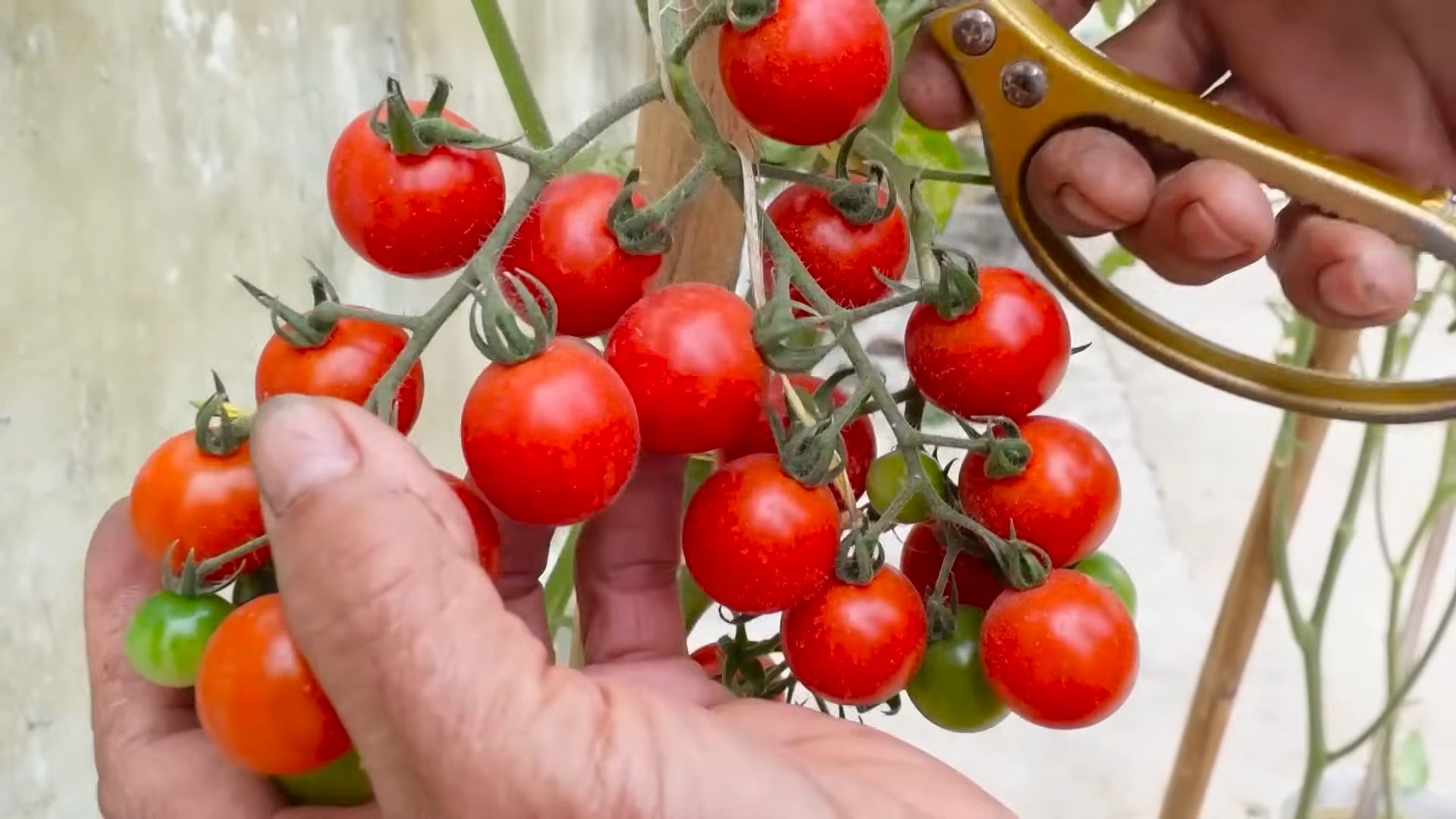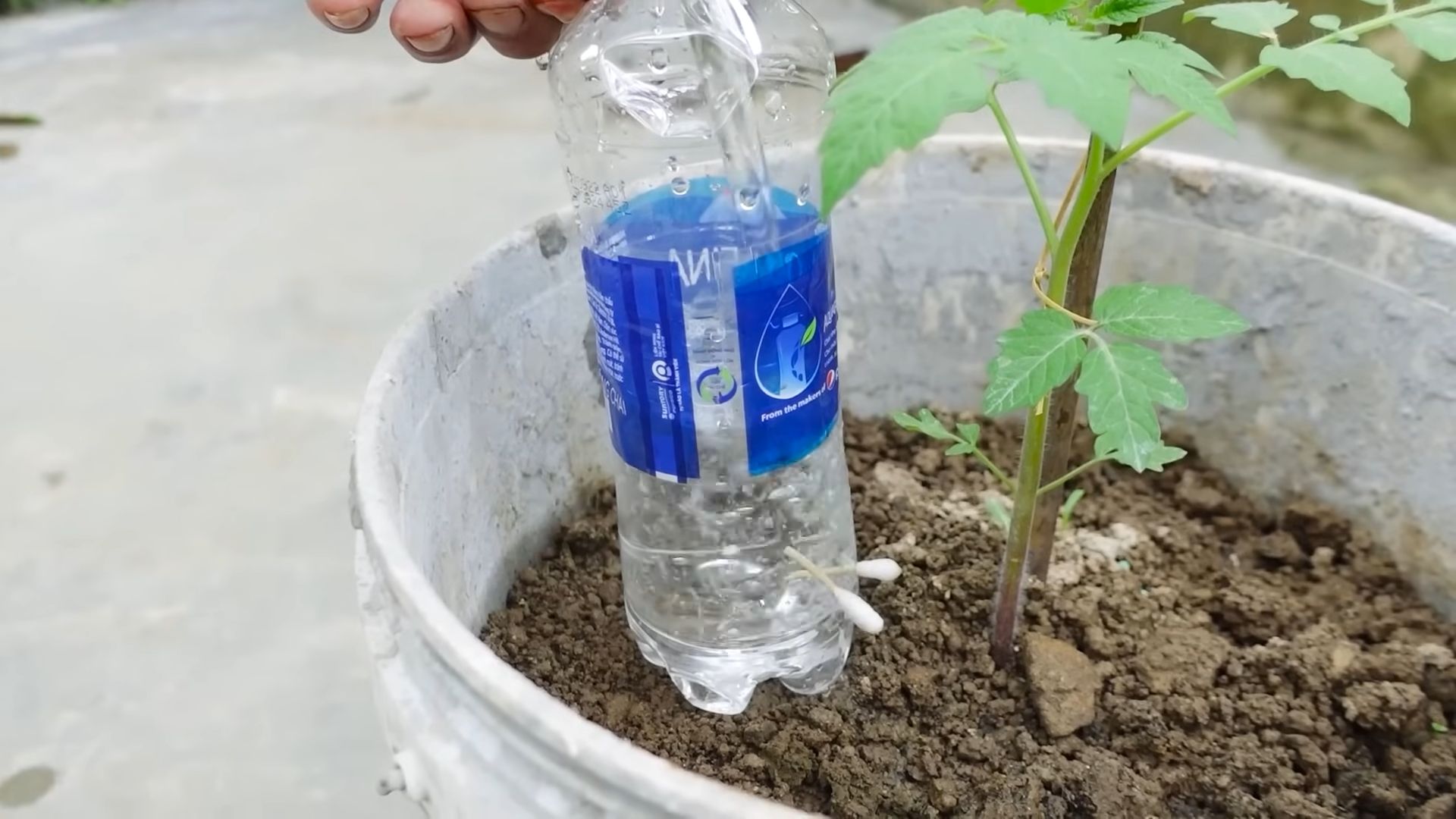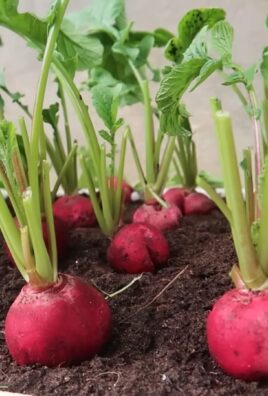Growing Grape Tomatoes can be incredibly rewarding, offering a burst of sweet, tangy flavor straight from your backyard. Imagine popping those tiny, juicy gems into your mouth, knowing you nurtured them from seed to deliciousness! But let’s be honest, sometimes getting those perfect, prolific grape tomato harvests feels more like a battle than a breeze.
For centuries, home gardening has been a source of sustenance and joy. From ancient Roman kitchen gardens to the victory gardens of World War II, growing your own food connects us to a rich history of self-sufficiency and a deeper appreciation for nature. Now, with busy lives and limited space, we need clever solutions to maximize our yields and minimize the effort. That’s where these DIY tricks and hacks come in!
Are you tired of spindly plants, blossom end rot, or a measly handful of tomatoes after all your hard work? I know I was! That’s why I’ve compiled these simple, yet effective, DIY techniques to help you achieve a bumper crop of delicious grape tomatoes. Whether you’re a seasoned gardener or just starting out, these tips will empower you to overcome common challenges and unlock the secrets to growing grape tomatoes like a pro. Get ready to transform your garden and enjoy the sweet taste of success!

Growing Grape Tomatoes: A DIY Guide to a Bountiful Harvest
Hey there, fellow gardening enthusiasts! I’m so excited to share my tried-and-true method for growing delicious, juicy grape tomatoes right in your own backyard (or even on your balcony!). Grape tomatoes are super rewarding to grow – they’re prolific, relatively easy to care for, and perfect for snacking, salads, or adding a burst of flavor to your favorite dishes. Let’s dive in!
Choosing the Right Variety
Before we get our hands dirty, it’s important to pick the right grape tomato variety for your climate and growing space. Here are a few of my favorites:
* ‘Sungold’: These are incredibly sweet and have a beautiful golden-orange color. They’re a bit more prone to cracking, but the flavor is worth it!
* ‘Juliet’: A classic red grape tomato that’s known for its disease resistance and high yields.
* ‘Santa’: Another reliable red variety with a slightly elongated shape and a good balance of sweetness and acidity.
* ‘Black Pearl’: If you’re feeling adventurous, try these dark purple grape tomatoes. They have a unique, slightly smoky flavor.
Consider your local climate and the amount of sunlight your garden receives when making your choice. Most grape tomato varieties need at least 6-8 hours of sunlight per day.
Getting Started: From Seed to Seedling
I usually start my grape tomato seeds indoors about 6-8 weeks before the last expected frost. This gives them a head start and ensures a longer growing season.
1. Gather Your Supplies: You’ll need:
* Grape tomato seeds
* Seed starting trays or small pots
* Seed starting mix (a light, sterile mix is best)
* A spray bottle filled with water
* A heat mat (optional, but helpful)
* A grow light (optional, but highly recommended)
2. Sow the Seeds: Fill your seed starting trays or pots with seed starting mix. Moisten the mix thoroughly, but don’t soak it. Make a small indentation (about 1/4 inch deep) in the center of each cell or pot. Place 2-3 seeds in each indentation and gently cover them with more seed starting mix.
3. Water Gently: Use a spray bottle to mist the surface of the soil. Avoid overwatering, as this can lead to damping off (a fungal disease that can kill seedlings).
4. Provide Warmth and Light: Place the seed starting trays or pots on a heat mat (if using) and under a grow light. The ideal temperature for germination is around 75-80°F. If you don’t have a grow light, place the trays or pots in a sunny window, but be sure to rotate them regularly to prevent the seedlings from leaning towards the light.
5. Keep the Soil Moist: Check the soil moisture daily and mist with water as needed to keep it consistently moist, but not soggy.
6. Wait for Germination: Grape tomato seeds typically germinate in 5-10 days. Once the seedlings emerge, remove them from the heat mat (if using) and move the grow light closer to the seedlings (about 2-3 inches above the plants).
7. Thin the Seedlings: Once the seedlings have their first set of true leaves (the leaves that look like miniature tomato leaves), thin them to one seedling per cell or pot. Choose the strongest, healthiest-looking seedling and snip off the others at the soil line with scissors.
8. Harden Off the Seedlings: About a week before you plan to transplant the seedlings outdoors, you’ll need to “harden them off.” This process gradually acclimates the seedlings to outdoor conditions, preventing transplant shock. Start by placing the seedlings outdoors in a sheltered location for an hour or two each day, gradually increasing the amount of time they spend outdoors over the course of a week. Protect them from direct sunlight and strong winds.
Transplanting Your Grape Tomato Seedlings
Once the danger of frost has passed and the soil has warmed up, it’s time to transplant your grape tomato seedlings into their permanent home.
1. Choose a Sunny Location: Grape tomatoes need at least 6-8 hours of sunlight per day to thrive. Choose a location in your garden that receives plenty of sun.
2. Prepare the Soil: Grape tomatoes prefer well-drained soil that is rich in organic matter. Amend the soil with compost or well-rotted manure before planting.
3. Dig the Holes: Dig holes that are slightly larger than the root balls of your seedlings. Space the holes about 2-3 feet apart, depending on the variety. Some bushier varieties may need more space.
4. Plant the Seedlings: Gently remove the seedlings from their pots or trays. If the roots are circling the bottom of the pot, gently loosen them before planting. Place the seedlings in the holes and backfill with soil.
5. Bury Deep: This is a trick I swear by! Bury the stem of the tomato plant deeper than it was in the pot, removing the lower leaves. Tomatoes will grow roots along the buried stem, creating a stronger root system.
6. Water Thoroughly: Water the seedlings thoroughly after planting.
7. Add Support: Grape tomatoes can get quite tall and heavy, so it’s important to provide them with support. You can use stakes, cages, or trellises. I prefer cages because they provide all-around support and are easy to install. Place the support around the seedlings immediately after planting to avoid damaging the roots later on.
8. Mulch: Apply a layer of mulch around the base of the plants to help retain moisture, suppress weeds, and regulate soil temperature. I like to use straw or shredded leaves.
Caring for Your Grape Tomato Plants
Now that your grape tomato plants are in the ground, it’s time to provide them with the care they need to thrive.
1. Watering: Water your grape tomato plants deeply and regularly, especially during hot, dry weather. Aim to water at the base of the plants to avoid wetting the foliage, which can lead to disease. I usually water every 2-3 days, depending on the weather.
2. Fertilizing: Grape tomatoes are heavy feeders, so it’s important to fertilize them regularly. I like to use a balanced organic fertilizer, such as a 5-10-5 or 10-10-10, every 2-3 weeks. You can also use compost tea or fish emulsion.
3. Pruning: Pruning can help improve air circulation, reduce disease, and encourage fruit production. Remove any suckers (the small shoots that grow between the main stem and the branches) that appear below the first flower cluster. You can also remove any yellowing or diseased leaves.
4. Pest and Disease Control: Keep an eye out for common tomato pests, such as aphids, tomato hornworms, and whiteflies. You can control these pests with insecticidal soap or neem oil. To prevent diseases, such as early blight and septoria leaf spot, water at the base of the plants, provide good air circulation, and remove any diseased leaves promptly. I also like to spray my plants with a copper fungicide preventatively.
5. Pollination: Tomatoes are self-pollinating, but sometimes they need a little help, especially in hot or humid weather. You can gently shake the plants or use a small brush to transfer pollen from one flower to another.
Harvesting Your Grape Tomatoes
The best part! Grape tomatoes are typically ready to harvest about 60-80 days after transplanting.
1. Check for Ripeness: Grape tomatoes are ripe when they are fully colored and slightly soft to the touch.
2. Harvest Carefully: Gently pluck the tomatoes from the vine. Be careful not to damage the plants.
3. Harvest Regularly: Harvest your grape tomatoes regularly to encourage continued fruit production.
4. Enjoy Your Harvest: Eat them fresh, add them to salads, roast them, or make a delicious tomato sauce. The possibilities are endless!
Troubleshooting Common Problems
Even with the best care, you may encounter some problems while growing grape tomatoes. Here are a few common issues and how to address them:
* Blossom End Rot: This is caused by a calcium deficiency and results in a dark, leathery spot on the bottom of the tomato. To prevent blossom end rot, ensure that your soil is rich in calcium and water your plants consistently. You can also add calcium to the soil by mixing in crushed eggshells or bone meal.
* Cracking: This is caused by fluctuations in soil moisture. To prevent cracking, water your plants regularly and mulch around the base of the plants to help retain moisture.
* Sunscald: This is caused by excessive exposure to sunlight and results in white or yellow patches on the tomatoes. To prevent sunscald, provide your plants with some shade during the hottest part of the day.
*

Conclusion
So, there you have it! Growing grape tomatoes at home, while it might seem daunting at first, is incredibly rewarding and surprisingly simple with this DIY trick. Forget those bland, store-bought grape tomatoes that lack that burst of sunshine flavor. Imagine plucking perfectly ripe, intensely sweet grape tomatoes straight from your own garden, knowing exactly where they came from and how they were grown. That’s the power of taking control and embracing the joy of homegrown produce.
This method, focusing on [mention the specific DIY trick from the main article – assuming it’s something like “using coffee grounds as fertilizer” or “creating a DIY self-watering system”], isn’t just about saving money; it’s about enhancing the flavor and quality of your grape tomatoes. The [mention the benefit of the DIY trick, e.g., “coffee grounds provide essential nutrients” or “self-watering system ensures consistent moisture”] directly contributes to healthier plants and more flavorful fruit. Plus, it’s a fantastic way to reduce waste and be more sustainable in your gardening practices.
But don’t just take our word for it! We encourage you to give this DIY trick a try and experience the difference for yourself. There are so many ways to personalize this approach to suit your specific needs and preferences. For example, if you’re using coffee grounds, experiment with different ratios to find what works best for your soil. If you’re building a self-watering system, consider using recycled materials to make it even more eco-friendly. You could even try companion planting with basil or marigolds to further enhance the flavor and deter pests.
The possibilities are endless!
And remember, growing grape tomatoes is a journey, not a destination. There will be successes and challenges along the way, but that’s all part of the fun. Don’t be afraid to experiment, learn from your mistakes, and most importantly, enjoy the process.
We’re confident that with a little effort and this handy DIY trick, you’ll be harvesting baskets full of delicious, homegrown grape tomatoes in no time. So, grab your gardening gloves, get your hands dirty, and prepare to be amazed by the incredible flavor of your own homegrown bounty.
Now, we want to hear from you! Have you tried this DIY trick for growing grape tomatoes? What were your results? Do you have any tips or variations to share? Head over to the comments section and let us know. Your experiences and insights can help other gardeners achieve success and inspire even more people to embrace the joy of homegrown produce. Let’s build a community of thriving grape tomato growers!
Frequently Asked Questions (FAQ)
What are the best varieties of grape tomatoes to grow using this DIY trick?
While this DIY trick can benefit almost any variety of grape tomato, some tend to thrive particularly well. Consider varieties like ‘Juliet,’ known for its disease resistance and prolific yields, or ‘Sweet Gold,’ prized for its exceptional sweetness. ‘Red Robin’ is a great choice for container gardening due to its compact size. Ultimately, the best variety depends on your personal taste preferences and local climate. Research which varieties are best suited to your region and have a reputation for good flavor and disease resistance. Don’t be afraid to experiment with different varieties to find your favorites! Remember to check the seed packet or plant label for specific growing instructions for each variety.
How often should I apply [mention the specific DIY trick ingredient, e.g., coffee grounds] to my grape tomato plants?
The frequency of application depends on several factors, including the type of soil, the age of the plants, and the weather conditions. As a general guideline, if you’re using coffee grounds as fertilizer, apply a thin layer around the base of the plants every 2-3 weeks. Avoid piling the grounds directly against the stem, as this can lead to rot. If you’re using a self-watering system, monitor the water level regularly and refill as needed, typically every few days depending on the size of the reservoir and the weather. Always observe your plants closely for any signs of nutrient deficiencies or overwatering and adjust your application frequency accordingly. Yellowing leaves, stunted growth, or blossom end rot can indicate imbalances that need to be addressed.
Can I use this DIY trick for other types of tomatoes besides grape tomatoes?
Yes, absolutely! While this article focuses on grape tomatoes, the underlying principles of this DIY trick can be applied to other types of tomatoes as well. The benefits of [mention the benefit of the DIY trick, e.g., “coffee grounds providing nutrients” or “consistent watering”] are universal to all tomato plants. However, keep in mind that different tomato varieties have different needs. Larger varieties, such as beefsteak tomatoes, may require more frequent fertilization or a larger self-watering reservoir. Always research the specific needs of the tomato variety you’re growing and adjust your approach accordingly.
What are some common problems I might encounter when growing grape tomatoes, and how can I address them?
Several common problems can affect grape tomato plants, including pests, diseases, and nutrient deficiencies. Pests like aphids, whiteflies, and tomato hornworms can damage foliage and fruit. Regularly inspect your plants for signs of infestation and take appropriate action, such as using insecticidal soap or hand-picking pests. Diseases like early blight, late blight, and blossom end rot can also affect grape tomatoes. Choose disease-resistant varieties, provide good air circulation, and avoid overhead watering to minimize the risk of disease. Blossom end rot is often caused by calcium deficiency, which can be addressed by adding calcium to the soil or using a calcium-rich foliar spray.
How do I know when my grape tomatoes are ripe and ready to harvest?
Grape tomatoes are typically ready to harvest when they are fully colored (usually red, but can also be yellow, orange, or purple depending on the variety) and slightly soft to the touch. Gently squeeze the tomato; it should yield slightly but not be mushy. The stem should also detach easily from the plant. Taste is the ultimate test! If the tomato is sweet and flavorful, it’s ready to be enjoyed. Harvest regularly to encourage continued production. Overripe tomatoes can become soft and mushy, attracting pests and diseases.
What if I don’t have a garden? Can I still use this DIY trick to grow grape tomatoes?
Absolutely! Grape tomatoes are well-suited for container gardening, making them a great option for those without a traditional garden. Choose a large container (at least 12 inches in diameter) with good drainage. Use a high-quality potting mix and follow the same DIY trick instructions as you would for garden-grown tomatoes. Place the container in a sunny location that receives at least 6-8 hours of sunlight per day. Water regularly and fertilize as needed. You can even grow grape tomatoes indoors with the help of grow lights.
How can I store my harvested grape tomatoes to keep them fresh for longer?
The best way to store grape tomatoes is at room temperature, away from direct sunlight. Avoid refrigerating them, as this can affect their flavor and texture. If you have a large harvest, you can preserve grape tomatoes by canning, freezing, or drying them. Canned grape tomatoes can be used in sauces, soups, and stews. Frozen grape tomatoes can be added to smoothies or used in cooked dishes. Dried grape tomatoes make a delicious snack or can be used in salads and pasta dishes.




Leave a Comment